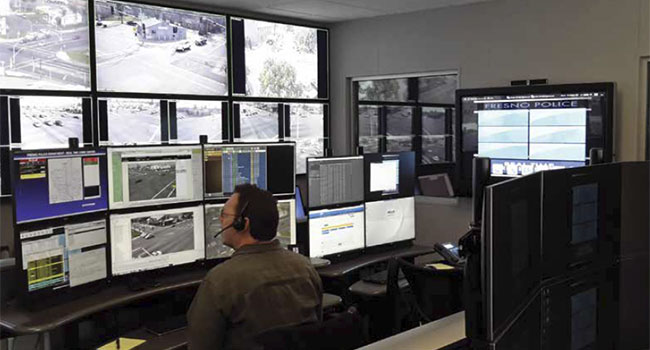
On the Tip of their Toes
Fresno PD may have technology advantage in their backyard
- By Ralph C. Jensen
- Aug 01, 2017
No matter where any given city places a video surveillance
camera, there are privacy concerns. There is,
however, another side to the story. There are those
community members who praise law enforcement
for placing cameras in their neighborhoods for
peace and security.
No one agency knows this better than the Fresno, Calif., Police
Department, and within the department, Sgt. Steve Casto, who has
been with the department for 21 years, and with the city’s FPD Crime
Center team for the past five years. Casto and FPD may have a slight
advantage because of a working relationship they have with nearby
neighbors, Pelco, which is based in Clovis, Calif.
“We’ve been working with Pelco for the past 10 years, and to
our advantage, have been able to test and try their newest and latest
technology efforts,” Casto said. “We work very closely with Pelco on
city video surveillance. We have placed cameras at many major intersections
throughout the city, with a large concentration in downtown
Fresno. Using crime data, we try and determine the best locations to
place our cameras.
The city of Fresno is an interesting case study in city surveillance,
to say the least. Law enforcement has about 200 of their own cameras
that they monitor throughout the city, plus 250 cameras in traffic operations,
plus, nearly 3,000 cameras associated with the Fresno Unified School District. They are able to stay on
top of the surveillance, in large part, because
of the video management software they use
from Pelco, and because of their technology
partnership with the Pelco advanced technology
and engineering leadership team.
The VMS, VideoXpert, is the gateway
whereby all network traffic passes, and is the
portal that connects not only the cameras but
other features the crime center has deployed.
For instance, FPD has deployed ShotSpotter
software and sensors in various neighborhoods
in the city; places where law enforcement
has identified active gangs or higher
crime statistics. When a suspected gunshot is
picked up by at least three of the sensors, it is
triangulated to a specific location and police
are able to respond much quicker. ShotSpotter
is able to provide officers on the streets
with real-time information, a map of the location
and an audio file that can be played in
the squad car.
“Beyond gathering and displaying information,
a critical role of that VMS is to help
contextualize information in a way that can
be easily understood by officers, so they can
respond quickly and effectively in an emergency
situation,” said Ray Still, director of
advanced technology & engineering at Pelco.
“We love to try this new technology,”
Casto said. “We’re able to position our cameras
in response to in-progress incidents, and
when these images are viewed inside our
crime center, we have real-time situational
awareness of what is taking place in the city.”
Well, some of the city. Fresno has over
500,000 residents spread across a city covering
more than 115 square miles.
“We enjoy having the FPD as a partner
in technology development, and appreciate
their interactive communications
about product ideas,” Still said. “Our goal
is to provide solutions with meaningful innovation
when it is ready, and once we have
tested it in the office. It is convenient that we
have such a willing and informed partner,
such as FPD, to work with.”
With the partnership, there is a roadmap,
including the development of the VMS and
the cameras.
Cameras. Obviously cameras need to provide
high quality video, with greater detail
and clarity, to support the security mission of
our customers. But, to better serve customers
in the future, cameras will also need to provide
a larger spectrum of information that is
not readily apparent to human observers.
“Metadata provided by video analytics
algorithms or thermographic information
are examples in current use,” Still said. “But
there are many other analytics that, to date,
have not been used to their full extent.”
VMS. The answer is a roadmap that includes
an increased focus on geographic
awareness, mobility and automation. By
combining these with an expanded spectrum
of information provided by cameras,
and leveraging deep learning capabilities, we
will enable our customers to not only better
detect security incidents, but also more effectively
mobilize their resources to respond to
those incidents.
Because the Fresno metropolitan area is
so spread out, there are several public and
private partnerships in the works, including
local shopping complexes, universities,
property developers and hospitals. The
partnership with FPD is ongoing, as well as
the department’s opportunity to continue
its role as an incubator of new things coming
down the road. Still said that much of
the work they are doing with FPD should
be completed by the end of the year. But,
by then, the engineers, integrators and end
users will have talked
again, and the drawing
board will be filled with
new ideas.
This article originally appeared in the August 2017 issue of Security Today.